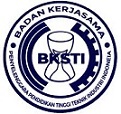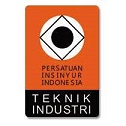Analyzing Cognitive Ergonomics and Key Determinants of Mental Workload in PDPT Operators at Universities
Abstract
The study commenced by quantitatively measuring the mental workload of Higher Education Operators (PDPT) through the NASA Task Load Index (NASA TLX). Results indicated an even distribution of mental workload between moderate and heavy levels, each comprising 50%. NASA TLX, a standard tool for assessing mental workload, offered insights into the operators' stress levels during task execution. Subsequently, Structural Equation Modeling (SEM) was employed to scrutinize factors impacting mental workload. Independent variables, encompassing completeness of data (CD), Feeder Dikti's time demands (FDTD), Internet network conditions (INC), task complexity (TC), and working period (WP), were tested against the dependent variable, the level of mental workload (LMW). This research provides a holistic understanding of factors contributing to PDPT operators' mental workload and how these factors influence the previously measured workload distribution with NASA TLX. This comprehensive insight adds context to the findings, forming a robust foundation for crafting more targeted management strategies to mitigate and manage mental workload in PDPT environments.
Keywords: Mental Workload, NASA TLX, Work Period, PDPT Operator
Full Text:
PDFReferences
M. A. Almaiah et al., “Determinants influencing the continuous intention to use digital technologies in Higher Education,” Electronics (Basel), vol. 11, no. 18, p. 2827, 2022.
M. Lei, I. M. Clemente, H. Liu, and J. Bell, “The acceptance of telepresence robots in higher education,” Int J Soc Robot, vol. 14, no. 4, pp. 1025–1042, 2022.
D.-G. Yu, Q. Li, W. Song, L. Xu, K. Zhang, and T. Zhou, “Advanced technique-based combination of innovation education and safety education in higher education,” J Chem Educ, vol. 100, no. 2, pp. 507–516, 2023.
D. C. Dewi, “Analisa Beban Kerja Mental Operator Mesin Menggunakan Metode Nasa Tlx Di Ptjl,” Journal of Industrial View, vol. 2, no. 2, pp. 20–28, 2020.
M. Mohammadian, H. Parsaei, H. Mokarami, and R. Kazemi, “Cognitive demands and mental workload: A filed study of the mining control room operators,” Heliyon, vol. 8, no. 2, p. e08860, 2022.
B. Febrilliandika and A. E. Nasution, “Pengukuran Beban Kerja Mental Kuliah Daring Mahasiswa Teknik Industri Usu Dengan Metode Nasa-Tlx,” in Seminar Dan Konferensi Nasional IDEC, 2020, pp. 1–7.
R. Basco, J. F. Hair Jr, C. M. Ringle, and M. Sarstedt, “Advancing family business research through modelling nonlinear relationships: Comparing PLS-SEM and multiple regression,” Journal of Family Business Strategy, vol. 13, no. 3, p. 100457, 2022.
D. Tao, H. Tan, H. Wang, X. Zhang, X. Qu, and T. Zhang, “A systematic review of physiological measures of mental workload,” Int J Environ Res Public Health, vol. 16, no. 15, p. 2716, 2019.
F. Dehais, A. Lafont, R. Roy, and S. Fairclough, “A neuroergonomics approach to mental workload, engagement and human performance,” Front Neurosci, vol. 14, p. 268, 2020.
M. Z. A. Rizqiansyah, F. Hanurawan, and N. Setiyowati, “Hubungan antara beban kerja fisik dan beban kerja mental berbasis ergonomi terhadap tingkat kejenuhan kerja pada karyawan PT JASA MARGA (PERSERO) Tbk Cabang Surabaya Gempol,” Jurnal Sains Psikologi, vol. 6, no. 1, pp. 37–42, 2017.
F. N. Rahman and A. Y. Pratama, “Analisis Beban Kerja Mental Pekerja Train Distribution PT. Solusi Bangun Indonesia,” Jurnal Teknologi dan Manajemen Industri Terapan, vol. 1, no. I, pp. 7–14, 2022.
S. Zetli, “Hubungan beban kerja mental dan stres kerja pada tenaga kependidikan di kota Batam,” Jurnal Rekayasa sistem industri, vol. 4, no. 2, pp. 63–70, 2019.
G. N. Dimitrakopoulos, I. Kakkos, A. Anastasiou, A. Bezerianos, Y. Sun, and G. K. Matsopoulos, “Cognitive Reorganization Due to Mental Workload: A Functional Connectivity Analysis Based on Working Memory Paradigms,” Applied Sciences, vol. 13, no. 4, p. 2129, 2023.
S. Oah, R. Na, and K. Moon, “The influence of safety climate, safety leadership, workload, and accident experiences on risk perception: A study of Korean manufacturing workers,” Saf Health Work, vol. 9, no. 4, pp. 427–433, 2018.
M. Irfan, “Measurement of Mental Workload and Fatigue of Production Operator,” International Journal of Service Science, Management, Engineering, and Technology, vol. 1, no. 3, pp. 11–13, 2022.
V. Nino, D. Claudio, and S. M. Monfort, “Evaluating the effect of perceived mental workload on work body postures,” Int J Ind Ergon, vol. 93, p. 103399, 2023.
T. Butmee, T. C. Lansdown, and G. H. Walker, “Mental workload and performance measurements in driving task: A review literature,” in Proceedings of the 20th Congress of the International Ergonomics Association (IEA 2018) Volume VI: Transport Ergonomics and Human Factors (TEHF), Aerospace Human Factors and Ergonomics 20, Springer, 2019, pp. 286–294.
J. Ibáñez-Gijón, D. Travieso, J. A. Navia, A. Montes, D. M. Jacobs, and P. L. Frutos, “Experimental validation of COMETA model of mental workload in air traffic control,” J Air Transp Manag, vol. 108, p. 102378, 2023.
R. Spinelli, N. Magagnotti, and E. R. Labelle, “The effect of new silvicultural trends on mental workload of harvester operators,” Croatian Journal of Forest Engineering: Journal for Theory and Application of Forestry Engineering, vol. 41, no. 2, pp. 1–13, 2020.
S. Yan, Y. Wei, and C. C. Tran, “Evaluation and prediction mental workload in user interface of maritime operations using eye response,” Int J Ind Ergon, vol. 71, pp. 117–127, 2019.
M. Zimmer, A. Al-Yacoub, P. Ferreira, E.-M. Hubbard, and N. Lohse, “Mental workload of local vs remote operator in human-machine interaction case study,” in Advances in Manufacturing Technology XXXIV, IOS Press, 2021, pp. 33–38.
N. F. S. Jeffri and D. R. A. Rambli, “A review of augmented reality systems and their effects on mental workload and task performance,” Heliyon, vol. 7, no. 3, p. e06277, 2021.
M. Pagnotta, D. M. Jacobs, P. L. de Frutos, R. Rodríguez, J. Ibáñez-Gijón, and D. Travieso, “Task difficulty and physiological measures of mental workload in air traffic control: a scoping review,” Ergonomics, vol. 65, no. 8, pp. 1095–1118, 2022.
G. Murugesan et al., “Assessment of mental workload by visual motor activity among control group and patient suffering from depressive disorder,” Comput Intell Neurosci, vol. 2022, 2022.
D. Safiu, I. Suryadi, A. R. Prastiwi, and M. Kahfi, “Work Stress On Women Workers Who Have A Mental Workload And Services For The Weaving of The Textile Industry,” Journal of Environmental and Safety Engineering, vol. 1, no. 1, pp. 7–13, 2022.
N. F. S. Jeffri and D. R. A. Rambli, “A review of augmented reality systems and their effects on mental workload and task performance,” Heliyon, vol. 7, no. 3, p. e06277, 2021
DOI: http://dx.doi.org/10.24014/jti.v10i1.23407
Refbacks
- There are currently no refbacks.
Copyright (c) 2024 Rezki Amelia Aminuddin A.P.

This work is licensed under a Creative Commons Attribution-NonCommercial-ShareAlike 4.0 International License.
Jurnal Teknik Industri
P-ISSN 2460-898X | E-ISSN 2714-6235
Published by:
Industrial Engineering Department
Universitas Islam Negeri Sultan Syarif Kasim Riau, Indonesia
Office Address:
H.R. Soebrantas KM 15.5, Tampan, Pekanbaru, Riau, Indonesia 28293
email: jti.fst@uin-suska.ac.id
Indexed by:
JTI : Jurnal Teknik Industri under a Creative Commons Attribution-NonCommercial-ShareAlike 4.0 International License.

















